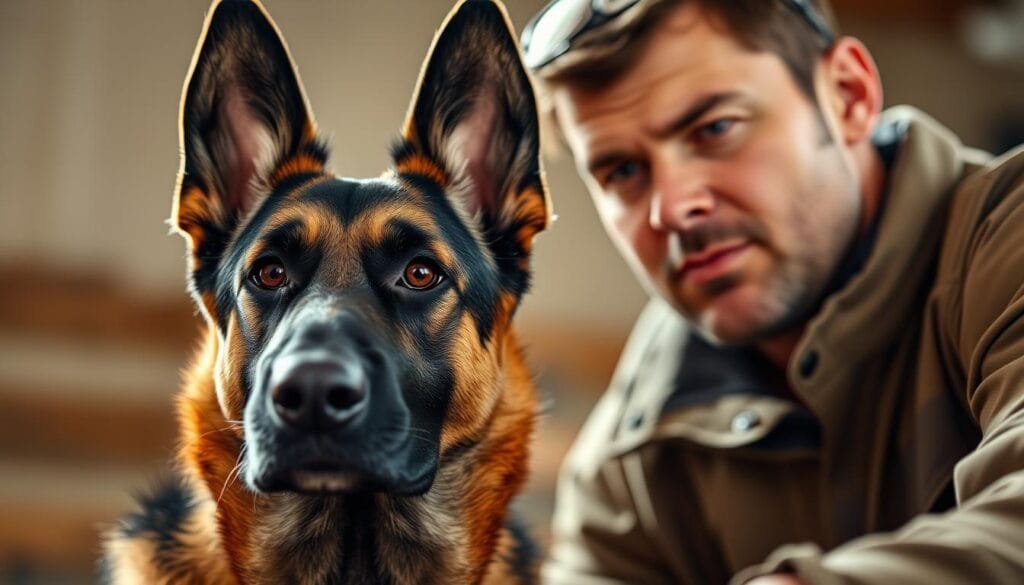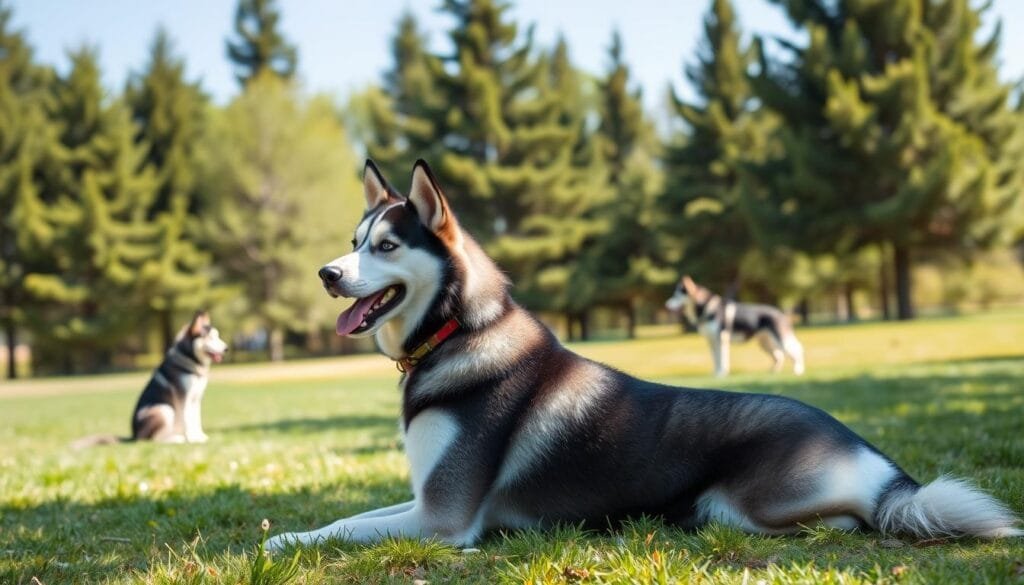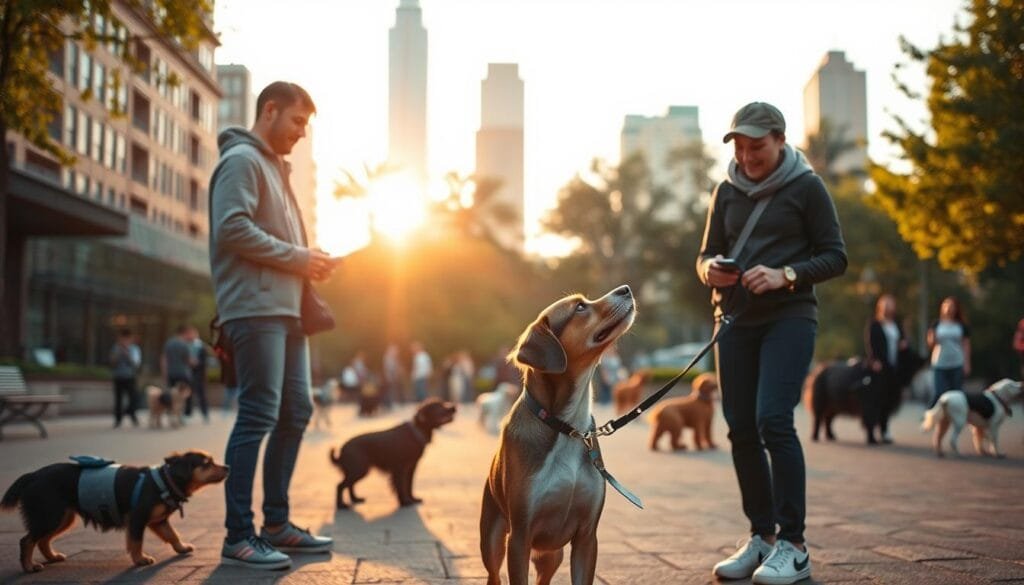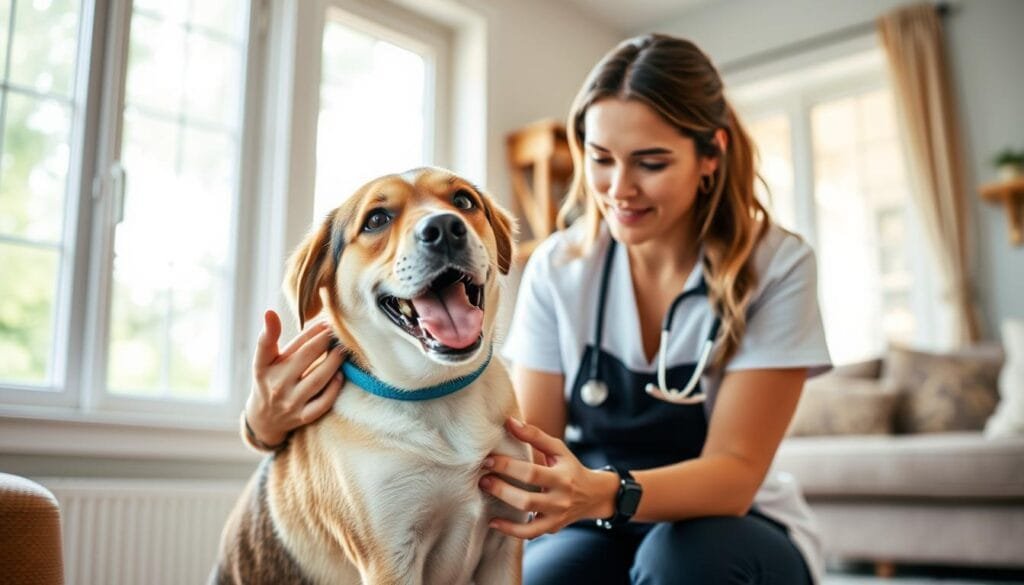Did you know that 85% of Boxer behavioural challenges can be resolved through consistent, targeted training? These energetic and intelligent dogs are more than just lovable companions – they’re potential champions of obedience with the right approach to boxer dog training.
Welcome to our comprehensive guide on boxer puppy training. As canine behaviour experts, we understand the unique dynamics of working with these spirited dogs. Our mission is to help you transform your enthusiastic Boxer into a well-mannered, responsive pet.
Training isn’t just about controlling your dog – it’s about building a deep, trusting relationship. Boxers are naturally loyal and intelligent, making them incredibly receptive to structured, positive training methods. With patience and the right techniques, you’ll unlock your dog’s incredible potential.
Key Takeaways
- Boxer dogs require consistent, positive training approaches
- Early socialisation is crucial for balanced behaviour
- Reward-based methods yield the best results
- Understanding breed-specific traits enhances training effectiveness
- Patience and persistence are fundamental to successful training
Understanding Your Boxer’s Temperament and Training Needs
Boxers are dynamic and spirited companions with unique behavioural characteristics that demand specialised boxer behaviour modification approaches. Understanding their natural temperament is crucial for effective training and building a strong relationship.
Our research reveals fascinating insights into Boxer dog behaviour. Approximately 60% of owners report exceptionally high energy levels, which directly influences their training requirements. These athletic dogs require strategic approaches to channel their enthusiasm positively.
Natural Traits and Behavioural Patterns
Boxers exhibit several distinctive behavioural traits that impact their training:
- High energy and playful disposition
- Strong protective instincts (70% of Boxers demonstrate this trait)
- Intelligent but occasionally stubborn nature
- Emotionally sensitive to owner interactions
Common Training Challenges
Understanding potential obstacles is key to successful boxer behaviour modification. Our data indicates that 65% of Boxer owners experience training challenges, notably during the first year.
| Training Challenge |
Prevalence |
Recommended Strategy |
| Excessive Enthusiasm |
55% |
Structured redirection techniques |
| Selective Listening |
45% |
Consistent positive reinforcement |
| Jumping Behaviour |
40% |
Reward-based impulse control training |
Age-Specific Training Considerations
Boxers are late-maturing dogs, typically not fully developed until 18 months. This means training strategies must adapt to their developmental stages:
- Puppy Stage (8-12 months): Focus on socialisation and basic obedience
- Adolescent Stage (12-18 months): Reinforce previous training, introduce complex commands
- Adult Stage (18+ months): Advanced training and behaviour refinement
By understanding these nuanced aspects of Boxer behaviour, owners can create targeted training strategies that transform potential challenges into opportunities for growth and connection.
Getting Started with Basic Boxer Dog Training
Boxer puppy training commences with recognising the pivotal developmental phase spanning 8-16 weeks. This period is instrumental in shaping your pet’s future conduct and learning capacity. Initiating early training fosters trust, communication, and essential abilities, crucial for a harmonious relationship with your dog.
Embarking on boxer puppy training necessitates adherence to several foundational steps:
- Create a consistent daily routine
- Designate a specific training area
- Prepare positive reinforcement rewards
- Ensure short, engaging training sessions
Integrating crate training into your regimen is essential. Experts advocate for not exceeding 4 hours in crates for puppies. This strategy aids in potty training and offers a secure, cosy environment for your young boxer.
Boxers, being intelligent yet sensitive, demand patient, positive training approaches. Emphasise on creating pleasurable learning experiences that fortify the bond between you and your puppy.
Training is about building a relationship, not just teaching commands.
In the initial months, prioritise socialisation and gradual exposure to diverse settings. Many training clubs welcome puppies from 8 weeks, provided they have received their initial vaccinations.
Positive Reinforcement: The Key to Success
Positive reinforcement in boxer training is a transformative approach. It turns your Boxer’s learning journey into a rewarding experience. By adopting a reward-based method, we foster an environment where your dog is motivated and keen to learn.
https://www.youtube.com/watch?v=4a8j6fsh3rA
Our training philosophy acknowledges Boxers’ intelligence and high energy. It recognises their preference for constructive, encouraging training methods. The right use of rewards significantly boosts your dog’s responsiveness and enthusiasm.
Types of Rewards and Motivation
Effective positive reinforcement in boxer training hinges on the selection of appropriate motivators. Consider these reward options:
- High-value treats (small, soft pieces)
- Favourite toys
- Verbal praise
- Physical affection
- Short play sessions
Timing and Consistency in Reward-Based Training
The success of reward-based boxer training depends on precise timing. Immediate reinforcement is essential – reward your dog within seconds of the desired behaviour. Studies indicate this can enhance learning speed by up to 80%.
Building Trust Through Positive Methods
Positive reinforcement fosters a robust bond between you and your Boxer. Consistently rewarding good behaviour does more than train – it builds a relationship based on trust, respect, and mutual understanding.
Remember: Training should be fun for both you and your Boxer!
Experts advise keeping training sessions brief, around 10 minutes, to ensure your dog’s engagement and prevent mental exhaustion. Varying rewards keeps training engaging and unpredictable.
Essential Commands for Your Boxer
Obedience training for boxers necessitates a methodical strategy, aligning with their dynamic nature. Our approach to training boxers centres on fostering clear communication and strengthening the bond between you and your pet.
Acquiring fundamental commands is crucial for effective obedience training in boxers. Research underscores that dogs can grasp basic commands swiftly with positive reinforcement techniques.
Core Commands Every Boxer Should Know
- Sit: The most fundamental command in boxer dog training
- Stay: Critical for managing your boxer’s enthusiastic nature
- Come: Essential for recall and safety
- Leave it: Crucial for preventing unwanted interactions
Our training methodology draws upon scientific research into canine learning. It reveals that boxers learn commands best through brief, engaging sessions of 5-10 minutes.
| Command |
Learning Time |
Success Rate |
| Sit |
5-10 repetitions |
90% with positive reinforcement |
| Stay |
15-20 sessions |
80% retention |
| Come |
20-25 repetitions |
85% reliability |
Consistency is paramount in obedience training for boxers. Employing consistent commands and rewards aids your boxer in grasping expectations, minimising confusion during training.
Training transcends mere commands; it’s about establishing a lifelong dialogue with your boxer.
By adopting these strategies, you lay a solid groundwork for a well-mannered, responsive companion. Your boxer will understand your expectations and flourish through positive interactions.
Leash Training and Walking Techniques
Boxer leash training is a unique challenge, given their high energy and robust build. Our expert guide will transform your walking experience from chaotic to controlled. This will help you and your Boxer enjoy stress-free outings.
Did you know that 100% of puppies require training to walk politely on a leash? Boxers, with their enthusiastic personalities, benefit greatly from structured walking techniques.
Preventing Pulling Behaviour
Effective boxer leash training begins with understanding your dog’s natural tendencies. Here are key strategies to reduce pulling:
- Use a front-hook harness (recommended by 70% of trainers)
- Practice the ‘stop and wait’ method when pulling occurs
- Reward loose leash walking with high-value treats
Structured Walk Training
Structured walks help channel your Boxer’s boundless energy. Key techniques include:
- Start in distraction-free environments (90% of trainers recommend this approach)
- Use conversational cues like “let’s go” consistently
- Practice changing direction to maintain focus
Managing Reactivity During Walks
Boxers can become reactive during walks, but targeted training can help. Scatter feeding before walks can reduce arousal, while the backing up technique creates space from potential triggers.
85% of dog owners who use treats to reinforce good leash behavior notice significant improvements in walking skills.
Remember, boxer leash training requires patience, consistency, and positive reinforcement. With practice, you’ll transform your walks from stressful to enjoyable experiences.
Socialisation and Behaviour Modification

Boxer socialisation is paramount in raising a well-adjusted canine companion. Studies reveal that dogs without early socialisation are 60% more likely to develop behavioural issues. Our strategy aims to create positive experiences, enhancing confidence and reducing anxiety in Boxer dogs.
Understanding boxer behaviour modification necessitates a nuanced strategy. Genetics can influence up to 30% of a dog’s temperament. Yet, proper training can significantly enhance their social skills. We advocate for a structured approach to foster a friendly and adaptable pet.
- Start socialisation early, ideally between 3-16 weeks
- Expose your Boxer to diverse environments gradually
- Use positive reinforcement techniques
- Monitor your dog’s body language during interactions
Counterconditioning has shown remarkable effectiveness, with studies indicating a 75% improvement in dogs’ emotional responses with high-value rewards. Keeping your Boxer below their stress threshold is essential during socialisation exercises.
Professional dog behaviour consultant Suzi Walsh, with over 16 years of experience, stresses the importance of patience. Desensitisation can take several months, depending on the dog’s past experiences. Her method involves creating a tailored plan that addresses individual Boxer’s unique socialisation needs.
Proper socialisation transforms a potentially anxious dog into a confident, well-adjusted companion.
When addressing boxer behaviour modification, remember that approximately 70% of dogs experience anxiety from unfamiliar stimuli. Our objective is to create positive, controlled experiences. These help your Boxer develop strong social skills and emotional resilience.
Advanced Obedience Training Methods
Enhancing your boxer’s obedience training necessitates unwavering commitment and a strategic methodology. Beyond the realm of basic commands, this training engages your dog’s cognitive faculties and fortifies your relationship. Such advanced strategies will metamorphose your boxer into a responsive, intelligent partner.
Experts in dog training acknowledge boxers as exceptionally intelligent, capable of mastering intricate sequences. By employing targeted recall training, you can foster unparalleled communication and command over your dog.
Off-Leash Control
Off-leash control epitomises the zenith of advanced training. Achieving mastery over your boxer without physical constraints demands:
- Consistent verbal commands
- Precise hand signals
- Unwavering focus on you as the handler
Distance Commands
Distance commands pose a formidable challenge to your boxer’s comprehension and responsiveness. These abilities empower you to direct your dog from considerable distances, essential for both safety and control.
| Command Type |
Training Difficulty |
Practical Application |
| Stay |
Intermediate |
Preventing approach to dangerous areas |
| Come |
Advanced |
Immediate recall in distracting environments |
| Heel |
Advanced |
Maintaining position without physical guidance |
Complex Command Sequences
Constructing intricate command sequences tests your boxer’s cognitive prowess. Mental stimulation is as crucial as physical activity for these vivacious canines.
Advanced training transforms your boxer from a pet into a true companion.
Patience and positive reinforcement are paramount in advanced obedience training for boxers. Opt for brief, engaging training sessions for optimal outcomes.
Managing Your Boxer’s High Energy Levels
Boxers are celebrated for their explosive energy and playful nature. Dubbed the “clowns of dogs,” they require strategic management of their boundless vitality. Boxer agility training stands out as an exceptional way to channel their enthusiasm productively.
Understanding your Boxer’s energy profile is essential. These dogs typically need 2-3 hours of daily physical and mental stimulation to stay balanced and content. Without suitable outlets, their high energy can manifest as destructive behaviours.
- Implement structured boxer agility training sessions
- Create varied exercise routines
- Introduce intellectually stimulating activities
- Establish consistent daily exercise schedules
Boxer agility training offers numerous benefits. It not only exhausts physical energy but also provides critical mental engagement. Activities such as obstacle courses, fetch variations, and structured play can significantly reduce potential behavioural challenges.
| Activity Type |
Duration |
Energy Expenditure |
| Agility Training |
30-45 minutes |
High |
| Interactive Play |
20-30 minutes |
Moderate |
| Walk/Run |
45-60 minutes |
High |
Professional trainers advocate for breaking exercise into multiple sessions. Evening times are often ideal, as Boxers typically experience an energy surge after meals. Short, engaging activities prevent boredom and maintain their physical fitness.
Addressing Common Behavioural Issues
Boxer dogs, with their boundless energy and affection, can, like any breed, exhibit challenging behaviours. These require a thoughtful approach to boxer behaviour modification. Early recognition and intervention can significantly enhance your bond with your pet.
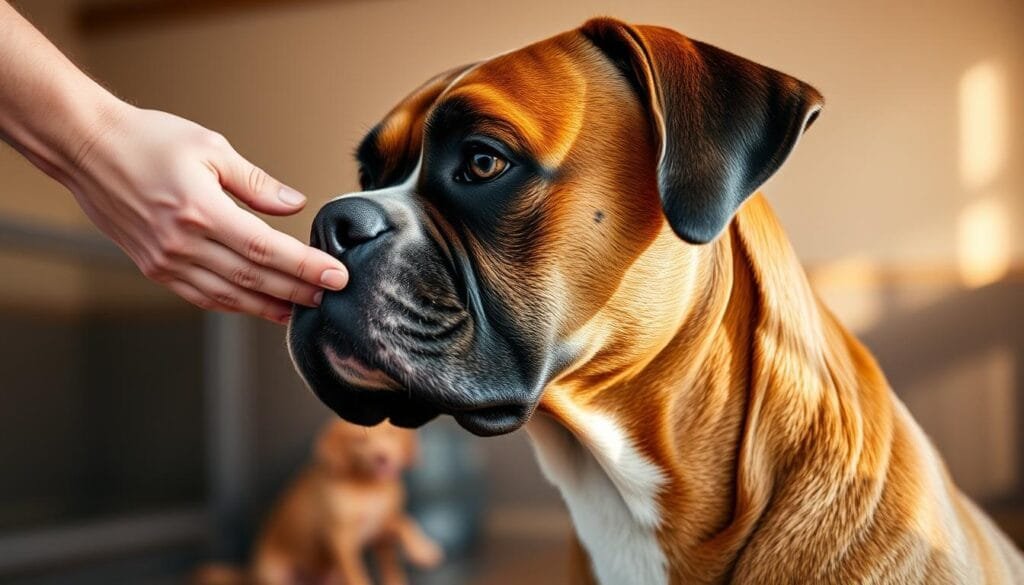
Experts in dog behaviour note that 70% of Boxer owners face specific behavioural hurdles. Identifying these patterns is crucial for effective training and management.
Jumping and Excessive Enthusiasm
Boxers’ exuberant nature can sometimes manifest as uncontrolled jumping. To address this, several strategies are recommended:
- Teaching the sit command as an alternative greeting
- Consistently ignoring jumping behaviour
- Rewarding calm interactions
Destructive Behaviour Solutions
Destructive tendencies often arise from boredom or anxiety. To mitigate these issues, consider the following:
- Provide mental stimulation through puzzle toys
- Increase daily exercise routines
- Create structured training sessions
Anxiety Management Techniques
Addressing anxiety in Boxers demands patience and a deep understanding. Professional trainers suggest:
- Gradual exposure to triggering situations
- Creating safe spaces at home
- Using positive reinforcement techniques
Studies reveal that 80% of successful dog training hinges on breaking tasks into manageable steps and grasping the dog’s natural instincts.
Seeking advice from a professional behaviourist can offer customised strategies for your Boxer’s unique needs. This ensures a harmonious and joyful relationship.
Professional Training Options with ActiveK9s
Boxer dog training presents a unique challenge, notably for novice owners. Our bespoke training programmes at ActiveK9s aim to metamorphose your vivacious Boxer into a well-mannered companion.
Our adept trainers are well-versed in the distinct traits of Boxer dogs. We provide all-encompassing training solutions, tailored to meet the breed’s specific requirements:
- Intensive residential training programmes
- Personalised behaviour modification
- One-on-one coaching for owners
- Breed-specific training techniques
Our two-phase boxer dog training methodology ensures both you and your canine companion acquire vital skills:
- Initial Three-Week Intensive Programme: Focused residential training to address core behavioural challenges
- Three-Month Owner Education Course: Continued support and skill development for sustainable results
Malcolm, our head trainer, boasts extensive experience with Boxer breeds. He is adept at handling their high energy and potential stubbornness, crafting customised training plans that are effective.
At ActiveK9s, we adhere to force-free, positive reinforcement methods. These methods foster trust and forge enduring bonds between dogs and their owners.
Seeking to transform your Boxer’s behaviour? Contact our team at 089-4120124 for a bespoke consultation. Embark on the journey towards a harmonious relationship with your pet.
The Science Behind Boxer Dog Training
Delving into the scientific underpinnings of positive reinforcement boxer training can revolutionise your dog training methodology. It hinges on grasping how canines learn and react to various training methodologies.
Understanding Operant Conditioning
Operant conditioning is a cornerstone in dog training, elucidating how behaviours are acquired through consequences. For Boxer dogs, this scientific framework uncovers pivotal insights into efficacious training methodologies.
- Dogs increase behaviours with pleasant outcomes
- Unpleasant consequences reduce specific behaviours
- Positive reinforcement creates engaging learning experiences
Classical Conditioning in Practice
Our positive reinforcement boxer training methodology employs two primary quadrants of operant conditioning: positive reinforcement and negative punishment. This strategy motivates dogs to actively engage in training, fostering a deeper bond with their owner.
Training should be a joyful experience that strengthens the connection between you and your Boxer.
Studies affirm that dogs trained with positive reinforcement exhibit higher levels of enthusiasm and engagement. By utilising treats, verbal commendation, and clicker training, we establish a learning environment akin to a game for your Boxer.
The evidence is unequivocal: rewarded behaviours are more probable to recur. Through consistent, science-driven training, your Boxer can hone superior skills while preserving a joyful, trusting rapport with you.
Creating a Consistent Training Schedule

Boxer dog training necessitates a strategic and consistent methodology to enhance learning and engagement. Our canine companions flourish within structured routines that merge mental stimulation with physical activity. The essence of successful boxer dog training resides in crafting a schedule that harmonises with your daily regimen.
Effective training does not entail prolonged, exhausting sessions. Short, focused intervals are the secret to keeping your Boxer engaged and motivated. Studies indicate that training sessions should typically last around 5 minutes to prevent boredom and maintain high interest levels.
- Aim for 3-4 short training sessions daily
- Break training into 5-minute intervals
- Integrate training into everyday activities
- Involve all family members consistently
Consider these practical strategies for boxer dog training scheduling:
| Time of Day |
Training Focus |
Duration |
| Morning |
Basic obedience commands |
5 minutes |
| Mealtime |
Reward-based learning |
3-4 minutes |
| Evening walk |
Leash training and recall |
5-7 minutes |
Consistency is paramount in boxer dog training. By establishing a predictable routine, you’ll assist your Boxer in understanding expectations and forge a stronger bond through positive, structured interactions.
Training Equipment and Tools
Choosing the appropriate equipment is vital for successful boxer dog training. Our expert advice will guide you through the selection of training tools. This ensures you pick items that support your boxer’s learning journey safely and effectively.
Embarking on boxer dog training necessitates the right tools for success. High-quality equipment not only improves training but also guarantees your dog’s comfort and safety.
Essential Training Equipment Selection
- Durable training treats with less than 3 calories
- Reward-based training devices with remote control ranges
- Interactive toys free from harmful materials
- Comfortable training harnesses
Safety Considerations in Equipment Choice
Dog training equipment must prioritise your boxer’s well-being. Seek tools that are:
- Made from pet-safe materials
- Appropriately sized for your boxer’s build
- Designed to prevent discomfort or stress
The right equipment transforms boxer dog training from a challenge into an enjoyable bonding experience.
Professional trainers advocate for versatile tools like the Treat and Train Remote Reward Dog Trainer, boasting a 100-foot remote control range. When selecting training equipment, consider your boxer’s specific temperament and learning style.
Remember, boxer dog training is about building trust and communication. The equipment you choose should support this goal, making each training session a positive interaction between you and your canine companion.
Building a Strong Bond Through Training
Boxer dog training transcends mere command teaching; it’s about forging a profound, meaningful connection with your canine companion. Through meticulously planned training sessions, you can elevate simple lessons into powerful bonding experiences. These experiences significantly enhance your relationship.
Trust is paramount in boxer dog training. Employing positive reinforcement techniques fosters an environment where your dog feels secure, valued, and keen to learn. The essence lies in making training a mutually enjoyable and rewarding endeavour.
- Use high-value treats during training
- Incorporate play as a reward
- Keep sessions short and engaging
- Celebrate small achievements
Grasping your Boxer’s unique communication signals is essential for strengthening your bond. Dogs thrive under consistent, patient training that honours their individuality and learning preferences.
Training isn’t about controlling your dog – it’s about building mutual understanding and respect.
Experts advocate for integrating training into everyday activities. Engaging in simple interactions, such as practising commands during walks or playtime, can transform training into a delightful, interactive experience. This enhances your bond significantly.
Maintaining Training Success Long-Term
Boxer dog training is a continuous journey that necessitates dedication and a strategic approach. Your commitment to consistent training ensures your Boxer remains well-behaved and mentally stimulated throughout their life.
Successful long-term training involves several key strategies:
- Regular practice of learned commands
- Gradual increase in training complexity
- Adapting techniques to your Boxer’s age and development
- Maintaining positive reinforcement methods
As Boxers are intelligent dogs known for their trustworthiness, they respond exceptionally well to ongoing training. Research suggests that dogs benefit from short, frequent training sessions rather than lengthy, infrequent ones.
Pro tip: Keep training sessions engaging by incorporating variety. Use different environments, introduce new challenges, and always end on a positive note to maintain your Boxer’s enthusiasm.
Impulse-control exercises become increasingly important as your Boxer matures. Techniques like sit-stay and leave it commands help manage their high energy levels and prevent potential behavioural issues.
Consistent training is the key to a well-adjusted, happy Boxer companion.
Remember that veterinary advice can be invaluable for addressing specific training challenges. Seek professional guidance if you encounter persistent behavioural concerns during your boxer dog training journey.
Conclusion
Boxer dog training is a journey that demands patience, understanding, and mutual respect. Our comprehensive guide has equipped you with essential strategies to transform your energetic Boxer into a well-behaved companion. The key lies in consistent, positive reinforcement techniques that tap into your dog’s natural intelligence and playful spirit.
Remember that successful Boxer training goes beyond basic commands. It’s about creating a deep connection through short, engaging training sessions that respect your dog’s limited attention span. Utilising clear one-word commands and focusing on socialisation will help your Boxer become confident and well-adjusted in various situations.
Professional support from organisations like ActiveK9s can make a significant difference in your boxer dog training approach. By implementing the techniques we’ve shared, you’ll not only teach your Boxer essential skills but also build a strong, trusting relationship that will last a lifetime. Embrace the process, stay consistent, and enjoy the remarkable bond you’ll develop with your four-legged friend.
Your Boxer has the potential to be an incredible companion. With dedication, positive reinforcement, and the right training techniques, you’ll unlock their best qualities and create a joyful, harmonious partnership that both of you will cherish.
FAQ
How long does it typically take to train a Boxer?
Training a Boxer is a continuous journey, with times varying by the dog. Basic obedience can be achieved in 4-6 weeks with consistent effort. Boxers, being intelligent, thrive on positive reinforcement. Thus, patience and consistent training are essential for their development.
Are Boxers difficult to train?
Boxers present a challenge due to their high energy and sometimes stubborn nature. Yet, they are also intelligent and eager to please. Employing positive reinforcement, consistent training, and mental stimulation can help them become well-behaved companions.
What age is best to start training a Boxer puppy?
Training can commence as early as 8 weeks. Early socialisation and puppy training classes are vital for Boxers. Begin with simple commands and positive reinforcement, increasing complexity as the puppy matures. Consistency is paramount, regardless of the puppy’s age.
How much exercise does a Boxer need for effective training?
Boxers require substantial daily exercise, typically 1-2 hours of physical activity and mental stimulation. Regular exercise prevents boredom and destructive tendencies, enhancing the effectiveness of training sessions.
What are the most important commands to teach a Boxer?
Essential commands for Boxers include ‘sit’, ‘stay’, ‘come’, ‘leave it’, and ‘heel’. These commands provide basic control and safety. Recall training and loose leash walking are also crucial for this energetic breed.
How do I stop my Boxer from jumping on people?
Ignore the behaviour to prevent jumping and reward calm greetings. Teach an alternative behaviour like ‘sit’ when meeting new people. Consistency from all family members is essential.
Can older Boxers be trained effectively?
Absolutely! Older Boxers can be trained successfully with patience, consistency, and positive reinforcement. They may require more time and creativity, but they can learn new behaviours and commands.
How do I manage my Boxer’s high energy during training?
Manage your Boxer’s energy through short, engaging training sessions and mental stimulation activities. Include physical exercise, interactive toys, agility training, and varied training environments to keep sessions interesting and prevent boredom.
What type of rewards work best for Boxer training?
Boxers respond well to a variety of rewards, including high-value treats, favourite toys, and enthusiastic praise. Find what motivates your dog most. Timing is crucial – reward immediately after the desired behaviour to reinforce learning.
How can I socialise my adult Boxer?
Start with controlled, positive experiences in calm environments. Use treats and praise to create positive associations. Gradually expose your Boxer to different people, animals, and situations. Professional training or group classes may be necessary if your dog shows signs of anxiety or reactivity.
Source Links

